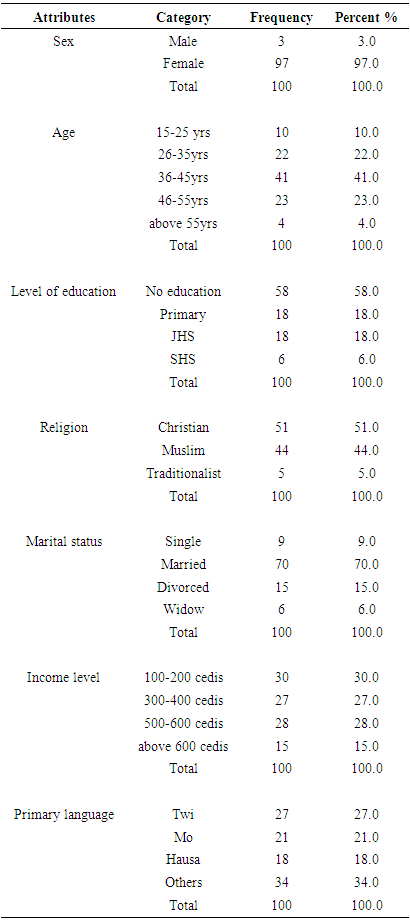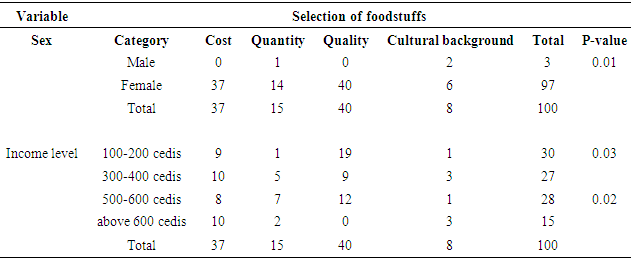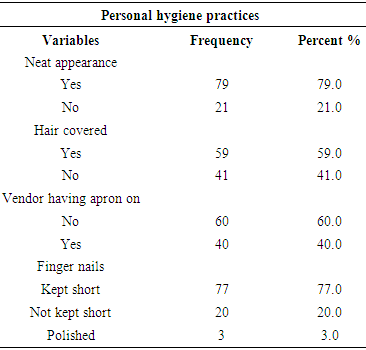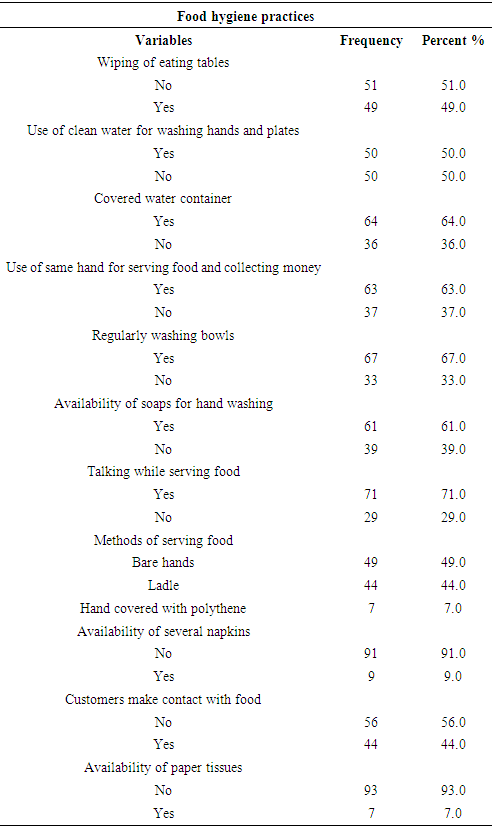-
Paper Information
- Next Paper
- Paper Submission
-
Journal Information
- About This Journal
- Editorial Board
- Current Issue
- Archive
- Author Guidelines
- Contact Us
Food and Public Health
p-ISSN: 2162-9412 e-ISSN: 2162-8440
2018; 8(1): 13-20
doi:10.5923/j.fph.20180801.03

Food Hygiene Awareness and Environmental Practices among Food Vendors in Basic Schools at Kintampo Township, Ghana
Dubik S. Dajaan1, Henry O. Addo2, Ojo Luke3, Afoakwa Eugenia4, Alhassan Amshawu5, Nwolley A. Kwasi6
1Kintampo L/A JHS, Ghana Education Service, Brong Ahafo Region, Kintampo, Ghana
2Department of Animal Biology and Conservation Science, University of Ghana, Legon, Ghana
3Faculty of Public Health and Allied Sciences, Catholic University College of Ghana, Brong Ahafo Region, Sunyani, Ghana
4Family Health University College, School of Nursing and Midwifery, Greater Accra Region, Teshie, Ghana
5Savelugu/Nanton Municipal Health Directorate, Northern region, Savelugu, Ghana
6Jomoro District Health Directorate, Western Region, Jomoro, Ghana
Correspondence to: Dubik S. Dajaan, Kintampo L/A JHS, Ghana Education Service, Brong Ahafo Region, Kintampo, Ghana.
| Email: |  |
Copyright © 2018 Scientific & Academic Publishing. All Rights Reserved.
This work is licensed under the Creative Commons Attribution International License (CC BY).
http://creativecommons.org/licenses/by/4.0/

Cooked food are handled by several individuals, these therefore increases the chances of contamination due to inappropriate handling. Contaminated food can have severe consequences on the health of school children as children have poorly developed immunity compared to adults. The study therefore, assesses food hygiene awareness and environmental practices among food vendors in basic schools at Kintampo Township by specifically determining the level of food hygiene awareness among food vendors and by observing environmental practices among food vendors. The study utilized an institutional based cross sectional survey to collect quantitative data from 100 food vendors in 20 basic schools. The quantitative data were coded and analyzed using the Statistical Package for Social Sciences (SPSS) software, version 20.0. It was found that, 91% was aware of food hygiene practices but poor in practice. There was a statistical association between awareness of food hygiene and age (Chi-square=15.505, P<.05). Selection of foodstuffs was dependent on vendors’ sex (Chi-square= 16.380, P<.01) and income level (Chi-square= 24.313, P<.05). About 91% did not have dustbins for waste collection while 91% of food vendors had no running water, 63% of food vendors use the same hand to serve food and collect money. Majority (71%) were talking while serving food. About 61% had soap for hand washing and 91% did not have many napkins for wiping of hands and cleaning of tables. The study therefore recommends provision of potable water in schools, regular supervision by health officers and intensification of food hygiene education in the schools.
Keywords: Personal hygiene, Foodborne diseases, Food vendors, School children
Cite this paper: Dubik S. Dajaan, Henry O. Addo, Ojo Luke, Afoakwa Eugenia, Alhassan Amshawu, Nwolley A. Kwasi, Food Hygiene Awareness and Environmental Practices among Food Vendors in Basic Schools at Kintampo Township, Ghana, Food and Public Health, Vol. 8 No. 1, 2018, pp. 13-20. doi: 10.5923/j.fph.20180801.03.
Article Outline
1. Introduction
- The school environment is one of several settings that can influence children food choices and eating habits [1]. Schools can ensure that the available food and beverages options are healthy, clean and help young people eat food that meet dietary recommendations for fruits, vegetables, whole grains, and non-fat dairy products [1].Millions of children are affected by serious, yet easily treatable and preventable illness, which inhibit their ability to learn across the developing world. Particularly school children are at risk due to the neglect of basic food and personal hygiene practices [2]. Unsafe food poses global health threats, endangering everyone. Infants, young children, pregnant women, the elderly and those with an underlying illness are particularly vulnerable. Food borne and waterborne diseases kill an estimated 2 million people annually, including many children and particularly in developing countries [3].Many cases of foodborne disease occur due to basic errors in food preparation or handling either in food service establishments or at home. Educating food handlers, including consumers, therefore, can significantly reduce the chances of contracting food-borne illnesses and the effects of outbreaks, as well as improve public health [4]. Food safety education programmes need to target certain segments of the population who, either directly have a role in food preparation and/or have increased vulnerability to foodborne diseases [4].The problem of foodborne diseases are more prominent in developing countries due to prevailing poor food handling and sanitation practices, inadequate food safety laws, lack of financial resources to invest on safer equipment, and lack of education for food handlers [5]. Hand washing is a precautionary measure to protect against the spread of disease and is one of the primary practices to reduce the transfer of bacteria from person to food contact surfaces. The main reason for limiting contact between ready-to-eat foods and people’s hands is to prevent the transfer of viruses and bacteria that are already present in human bodies [6].In developing countries, up to estimated 70% of cases of diarrheal diseases are associated with consumption of unwholesome food [7, 8].Most food vendors have good knowledge about food hygiene but poor knowledge in practice where they handle raw materials for food without washing their hands, fondled their bodies whiles preparing food [9].In Ghana, about 65,000 people die annually from foodborne diseases resulting in the loss of some US$69million to the economy. More often than not, food vendors are always at the end of accusing fingers for the spread of foodborne diseases, particularly cholera outbreaks, across the country and are sometimes banned as a desperate measure to control the outbreak [10]. There is an abundance of National legislation but limited resources to control food safety. Institutions such as the Ghana Standards Authority and the Food and Drugs Board are committed to the work of regulating food standards; however, improvement in food safety systems has not been fully realized and this is observed in recent reports of foodborne illness and contamination of vended foods with enteric bacteria in various parts of the country [11].Food hygiene has been describe by WHO as the conditions and measures necessary to ensure the safety of food from production to consumption. Food can become contaminated at any point during harvesting, processing, storage, distribution, transportation and preparation. Lack of adequate food hygiene can lead to foodborne diseases and death of the consumer [3].Ensuring food hygiene and safety practices among food vendors is one challenge that have existed for decades, and therefore the need for food vendors to adhere to proper food hygiene practices is very crucial [11].In Ghana, many studies have focused on food vendors in the street. There is no consistent knowledge on the practices of food vendors in Ghanaian Basic Schools as well as schools in the Kintampo Municipality. Considering the fact that children in basic schools depend on these food vendors for their diet during school hours, it will therefore be important to investigate and identify food hygiene awareness and environmental practices among these food vendors in basic schools. The exudes of school children from the surrounding villages to Kintampo township to get perceived quality education calls for concern in the basic schools. It is therefore necessary to ascertained food hygiene situations in the schools as food sold in these schools form part of the integral diet of these school children. Therefore, this study will be relevant for development of food safety interventions in educational institutions and for public health protection. This study will also serve as an eye opener especially in the area of school Health Education Programme (SHEP) as there is no recent data or research available on food hygiene situation in the basic schools at Kintampo Municipality.
2. Materials and Methods
2.1. Study Area
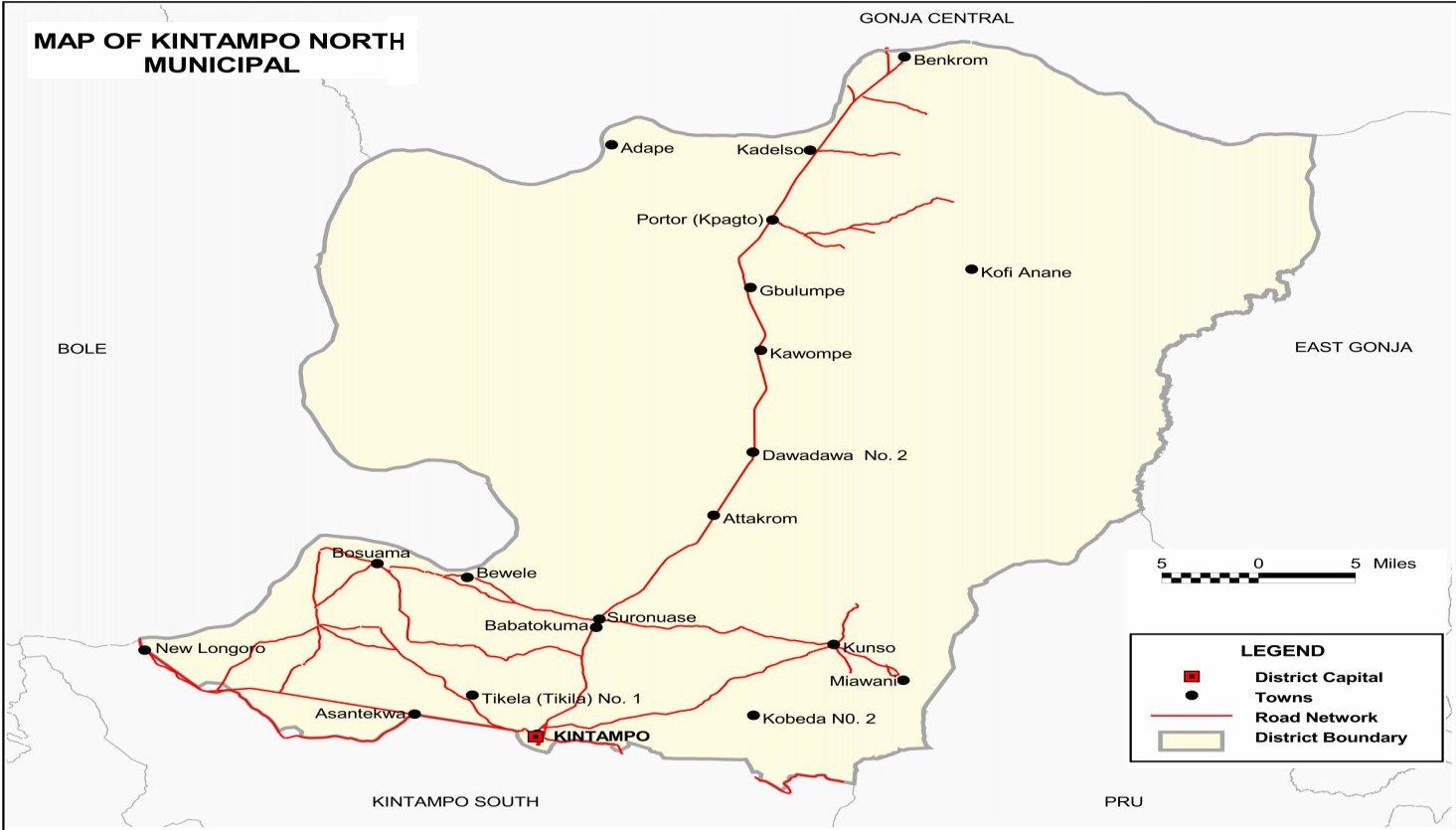 | Figure 1. Map showing Kintampo North Municipality |
2.2. Study Design
- An institutional based cross-sectional study was conducted to assess food hygiene awareness and environmental practices among food vendors in basic schools at Kintampo Township.
2.3. Source Population
- All food vendors who prepare and sell food in basic schools at Kintampo Township were the source population. The study focuses on only private food vendors who were selling food on site or in surrounding areas close to the selected schools as there are no institutional food vendors in the basic schools at Kintampo Township.
2.4. Study Population
- All food vendors who were randomly selected in the basic schools were the study population.
2.5. Inclusion Criteria
- All food vendors who sell food in the basic schools at Kintampo Township were included in the study. Also, food vendors who were not located in the schools but are close to the schools and sells food to pupils were included in the study.
2.6. Exclusion Criteria
- Food vendors (mobile food vendors) who move from school to school to sell food were not included in the study. Food vendors who declined to answer the questions were also excluded in the study.
2.7. Sample Size Determination
- Statistical Package for the Social Sciences (SPSS) Statistics version 20 was used to calculate for a sample size from an estimated population of 200 at an expected frequency of 30%, worst acceptable error of 24.38% at a confidence level of 95%. A sample size of 100 was thus derived which the researchers used as the sample size for the study.
2.8. Sampling Technique
- Simple Random sampling was used to select the schools that took take part in the study. The list of the basic schools in Kintampo Township was obtained from the Municipal Education Directorate; there are 21 accredited basic schools in Kintampo Township. The names of the schools were written on pieces of papers and placed into a bowl. The papers in the bowl were picked one at a time without looking directly into the bowl until the desired number was reached. With simple random sampling, 20 schools were selected to participate in the study. Food vendors were also randomly selected to participate in the study. The total number of food vendors that took part in the study were 100, that is, 5 food vendors were selected from each school.
2.9. Data Collection Procedure and Analysis
- The data collection techniques used in collecting the research data was questionnaires and observation checklist. Questionnaires were administered for collection of demographic information, level of food hygiene awareness among food vendors in basic schools. Observation checklists were used to collect data on environmental practices of food vendors in the schools. The quantitative data were coded and analyzed using the Statistical Package for Social Sciences (SPSS) software, version 20.0. Percentages in tables were computed for variables. Chi-square test was used to test for association between awareness of food hygiene and respondent age, selection of food stuffs and background attributes.
2.10. Data Quality Control
- Two data collectors who were final year students in Bsc. Public Health Education were recruited and trained to collect the data in 20 basic schools. Training was given on how to fill the questionnaire and do the observation using the observation checklist.
2.11. Ethical Consideration
- Before data collection, permission were obtained from Kintampo North Municipal Education Directorate. The headmasters/mistresses of the schools were verbally informed with prove of the permission letter obtained from the Municipal Education Directorate. Verbal consent was obtained from the respondents and they were assured of confidentiality of the information.
3. Results
3.1. Socio-demographic Characteristics of Respondents
- Table 1 represents the socio-demographic characteristics of 100 food vendors included in the study. With respect to gender, 97% were female food vendors while 10% were between the ages of 15-25 years, 22% were 26-35 years, 41% were 36-45 years, 23% were 46-55 years and 4% were above 55 years. Majority representing 58% had no formal education, 18% were primary school leavers, another 18% were JHS school leavers and 6% were SHS school leavers. 51% were Christians, 44% were Muslims and 5% were traditionalist, 70% representing majority of the respondents were married, 15% were divorced, 9% were single and 6% were widowed. 30% of the food vendors earned a monthly income of 100-200 Cedis, 27% earned 300-400 cedis, 28% earned 500-600 cedis and 15% earned above 600.
|
3.2. Food Hygiene Awareness
- A vast majority 91% indicated they were aware of food hygiene practices. With 32% indicated they have heard about food hygiene from the radio, 9% indicated information centre, 2% from television sources and 57% stated health officers as their source of awareness.Food vendors were asked if they receive education on food hygiene and the frequency at which they receive this education. 86% of the respondents affirmed that they have ever received health education on food hygiene. 44% indicated they receive the education yearly, 29% indicated monthly, 8% indicated weekly and 19% indicated not at all. On medical screening, majority (96%) of the respondents have ever undergone medical screening, 77% undergo this medical screening yearly and 18% monthly and 5% quarterly.Table 2. A chi-square test was conducted to test for an association awareness of food hygiene and respondents age. The results indicated a statistical association between awareness of food hygiene and age (Chi=15.505, P<.005). Age group 36-45 years has the greatest awareness of 41% while age group above 55 years has the least awareness of 2%.
|
|
3.3. Environmental Practices
- Table 4. It was observed that, half (50%) of food vendors had clean and neat surrounding. 91% did not have bins for waste collection; only 9% had waste collection bins and 87% had dustbins that were covered. 91% had no running water for selling while the remaining 9% did have. fifty-one (51%) had no toilet facilities and 49% had toilet facilities available to them.
|
3.4. Personal Hygiene Practices
- Table 5. It was observed that, 79% of food vendors had a neat appearance and 59% of the food vendors covered their hair during selling. Sixty (60%) had apron on and 40% did not have any apron on during selling of food. It was further observed that, 77% kept their finger nails short, 20% had long nails and 3% had a polished nail.
|
3.5. Food Hygiene Practices
- Table 6. It was observed that, 51% did not wiped tables used by consumers, 50% of food vendors used clean water for washing plates and hands, 64% covered their water container, 63% of the respondents use the same hand for serving food and collecting money. 67% washed their bowls regularly whiles 91% did not have many napkins for pupils’ to wipe their hands after eating and cleaning of tables. 71% of food vendors were observed to be talking while serving while 44% of customers were observed to be touching food before making their choice. 49% used their bare hands, 44% used ladles and 7% covered their hands with polythene bags when serving food.
|
4. Discussion
- Knowledge of the consequences of unsafe food hygiene practice can enhance adherence to food safety guidelines and therefore prevent food contamination [11]. The level of knowledge and awareness of food hygiene practices among food vendors was good; majority of the food vendors have heard of food hygiene before. This agrees with a study by Akabanda et al. [13] in Ghana which asserts that majority of the food handlers were knowledgeable about food hygiene practices, cleaning and sanitation procedures. The study also ascertained the awareness of food hygiene through a chi-square test and it was confirmed that, the awareness of food hygiene is dependent on individual age (Chi=15.505, P<.05), that is age has an influence on awareness of food hygiene. Age group 36-45 years had the greatest awareness and therefore may adhere strictly to food hygiene practices as compared to age group above 55 years, which has the lowest awareness. Frequent food hygiene education can help food vendors adhere to basic food hygiene practices thereby helping to prevent food contamination. Majority of the food vendors representing 86% of the food vendors have ever received health education on food hygiene practices. This is similar to a study by Monney et al. [11] in Ghana which found out that the schools and other bodies provided education on food hygiene and safety for food vendors wherein 87% of food vendors asserted themselves to have been educated by the school authorities or health workers on food hygiene. The food vendors also had some fair knowledge about food hygiene practice, but observational checklist revealed; food vendors have poor knowledge in practice. Food vendors’ knowledge and awareness about food hygiene did not translate into practice and therefore their knowledge may have not impact directly to handling of food. A study by Mugeta et al. [9] in Ethiopia yielded similar results as most handlers have good knowledge on food hygiene practices, however most of them have poor knowledge in practice where they handled raw materials for food without washing their hands; wore hand jewelleries and touched other parts of bodies whiles preparing food.Water is a critical raw material in many food-vended operations. Contaminated water can create a public health risk when it is used for drinking, washing of foods, incorporated in the food as an ingredient and used for washing equipment, utensils and hands [14]. The survey found out that majority of the vendors representing 91% had no running water at their place of selling. This means majority of the food vendors carried water from their various homes to the sales point which may not be enough for use. They therefore tend to reuse/recycle contaminated water for cleaning plates for eating by pupils, this can results in food contamination thereby having serious consequences on children health. This corresponds with a study by Hilarios [15] which found out that most vendors carry water from their homes because no potable water was available at their place of operation. Most of the food vendors did not have dustbins for waste collection as a result garbage and waste were visibly present at the place of selling. The presence of the garbage at the place of selling can attract more flies to the vending site thereby increasing the chances of the food being contaminated. This findings is in consonance with a study by Muinde et al. [16] in Kenya which found out that 92.5% of the vendors interviewed did not have garbage receptacles for waste collection, hence the disposal of garbage near their stalls. Lack of toilet and lavatory facilities at food vending and selling sites can force food vendors to seek secluded areas within their vending vicinity like bushes and uncompleted buildings for excretion [17]. More than half of the food vendors did not have access to toilet facilities at their place of selling. This affirmed a study by Idowu et al. [17] which stressed that most food vendors do not have access to any toilet facility whenever they are out selling; they therefore make use of dung hills and nearby bushes after which they clean up using sheets of papers; leaving their hands unwashed after defaecation. This therefore could have serious impact on the safety of food sold to school children as food vendors can easily contaminate the food with their unwashed hands.Observing personal hygiene is vital for any food establishment. Personal hygiene is important because human beings are the largest contamination sources of food [11]. Handling food with bare hands may result in cross contamination, hence introduction of microbes onto the food [11]. Personal hygiene practices of food vendors were observed to be generally good as majority of the food vendors had neat appearance; short finger nails and covered their hair during selling. The requirement of food handlers to wear aprons or to wear hair covering during preparation and sale of food is very important; wearing apron can help prevent the risk of cross contaminating the food with germs [14]. More than half of the food vendors representing 59% have their hair covered during selling, less than half of the food vendors did not have apron on during selling of food. Having long finger nails can harbor disease causing pathogens and can result in food contamination, it is therefore important for food vendors to always have their finger nails trimmed. Majority of the food vendors had their finger nails kept short, the situation is the same compared with a study conducted in Benin City, Nigeria where majority of the food vendors 93.4% had kept their nails short [18].The food hygiene practice were generally observed to be poor as almost all (91%) of the vendors did not have many napkins for pupils to wipe their hands whiles 71% were talking whiles serving food and most food vendors 63% uses the same hand to serve and collect money, this practice can lead to cross contamination of the food sold thereby leading to possible outbreak of foodborne diseases. This however disagrees with a study by Monney et al. [11] in Ghana which pointed out that food vendors in educational institutions generally adhere to food hygiene practices. Money makes for easy transfer of microorganisms and thus cross contamination, improper washing of hands after toilet, counting paper notes using saliva can lead to contamination therefore serving as a vehicle delivering bacteria to contaminate the hands of the next user [19], the survey revealed that majority of the food vendors representing 63% use the same hand for serving food and collecting money, this can cause cross contamination and trigger the outbreak of foodborne diseases in the schools. It was observed that half of the food vendors used clean water to wash plates. This is in variance with a study by Chukuezi [20] in Owerri, Nigeria which found out about 47.2% of food vendors washed their utensils with dirty water which is recycled. Majority of the food vendors did not have many napkins for wiping of hands and cleaning of tables, as a result pupils tend to use the same napkin to wipe their hands which can result in cross contamination. The most common practice that contaminates food and food environment is talking while serving food. This action results in copious amounts of saliva being dosed into the food [21], majority of the food vendors 71% were observed to be talking while serving food. Most pupils were observed to be touching food before making their choice; this action can result in transfer of contaminants from pupils’ hands to the food which can result in food contamination and can be a threat to the health of the next consumer. More than half of the food vendors used ladles and covered their hands with polythene bags when serving food, this practice is good for food safety as it can drastically reduce food contamination by food vendors. Food vendors are aware that using spoons and forks instead of the bare hands to serve food can reduce food contamination; defective personal hygiene can transmit pathogens from food vendors to customers [22].
5. Conclusions and Recommendations
- Food vending in basic schools form part of the integral diet of the school children. Food of good quality can affect the health, learning and physical activities of children of school-going age. Many of the food vendors underrate the school children and therefore do not strictly apply food hygiene practices to ensure that food served to school children are wholesome. Majority of the food vendors are aware of food hygiene practices but are poor in practice. Observational checklist revealed that most of the food vendors do not strictly adhere to basic food hygiene practices, although they are aware that not adhering strictly to food hygiene practices can lead to food contamination. There were minimal hygienic practices in the area of frequency of wiping of eating tables, availability of clean water for washing of cooking utensils, availability of dustbins for waste collection, and availability of several napkins for wiping of hands. Food vendors were observed to be talking whiles serving food and using the same hand to serve food and collect money.This paper therefore recommends that, government through the assembly should provide potable drinking water to the schools. This can be done through the provision of tap water or boreholes to the schools so that food vendors in the schools can have access to potable water.The Municipal Assembly of Kintampo Municipality should also make sure the supply dustbins and veronica buckets to the schools and to the food vendors in the schools to improve food hygiene and sanitation in the schools.The food hygiene practices were observed to be poor, food vendors should therefore be educated to observe basic food hygiene practices such as regular wiping of eating table, avoid talking whiles serving food, avoid using the same hand to serve food and collect money and should not allow pupils to make contact with food before making their choice.
ACKNOWLEDGEMENTS
- We are most grateful to all the food vendors and the schools that took part in the study. We are also grateful to the Kintampo Municipal Education Directorate and the headmasters/mistresses of the various schools that took part in the study.
 Abstract
Abstract Reference
Reference Full-Text PDF
Full-Text PDF Full-text HTML
Full-text HTML